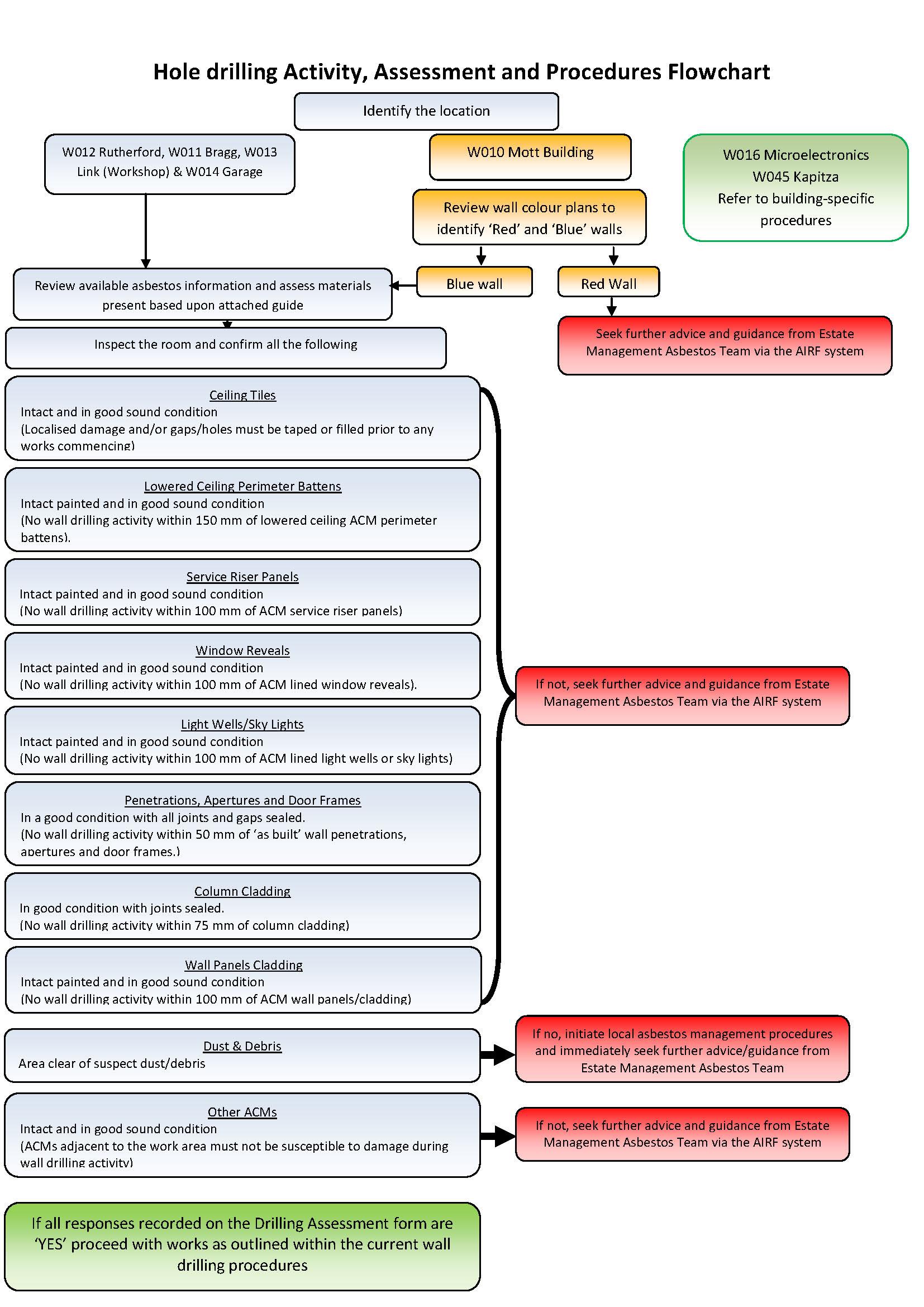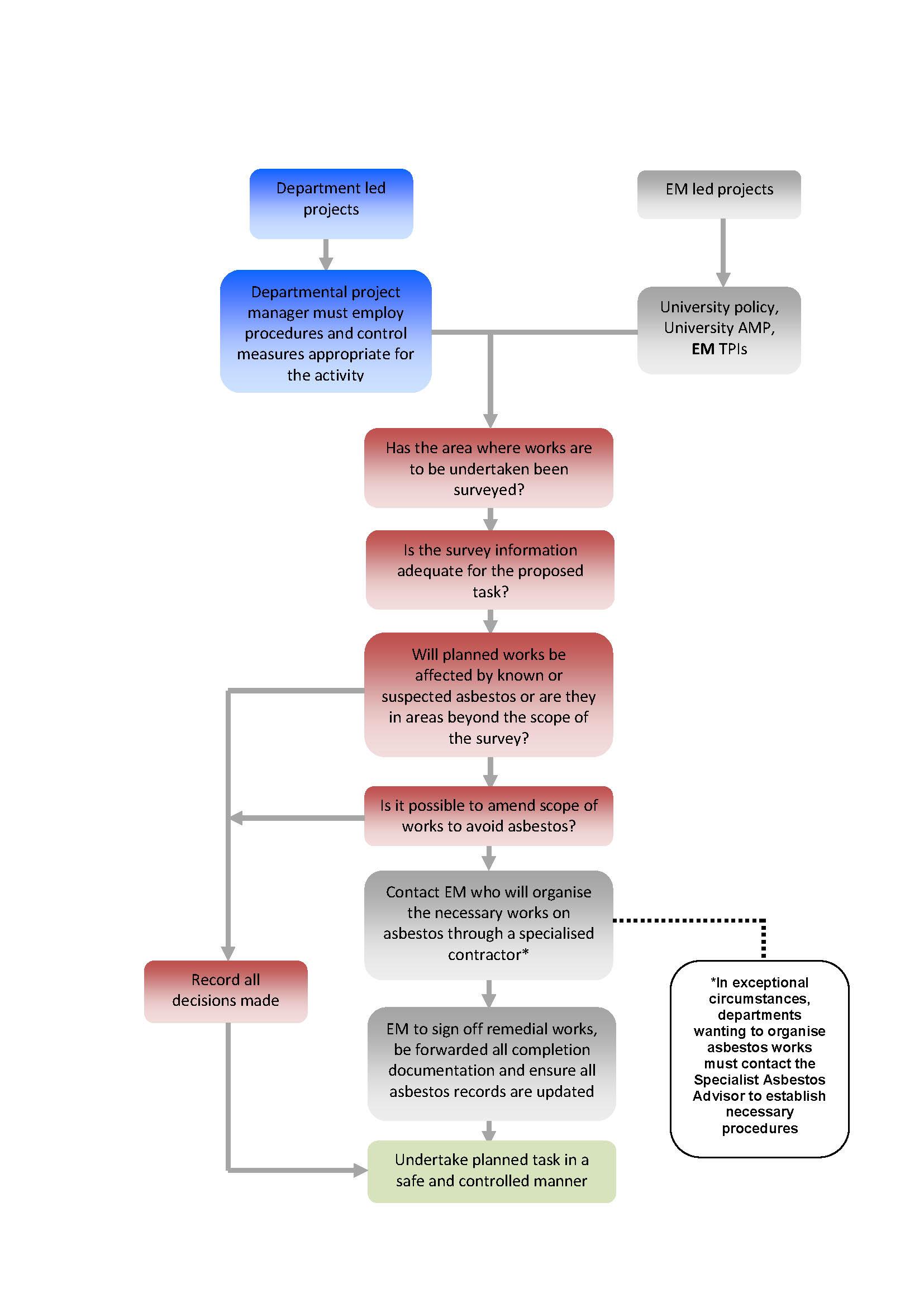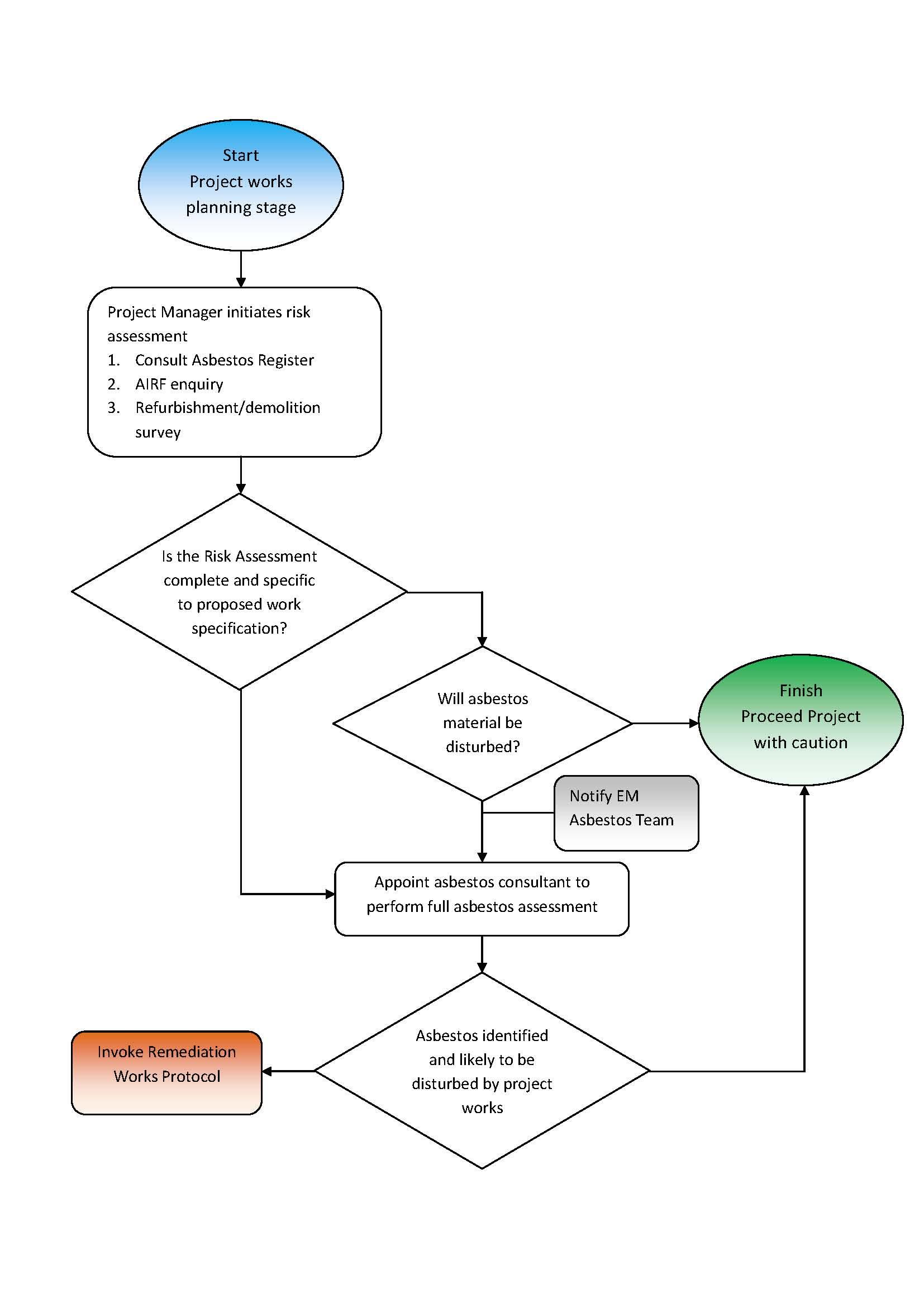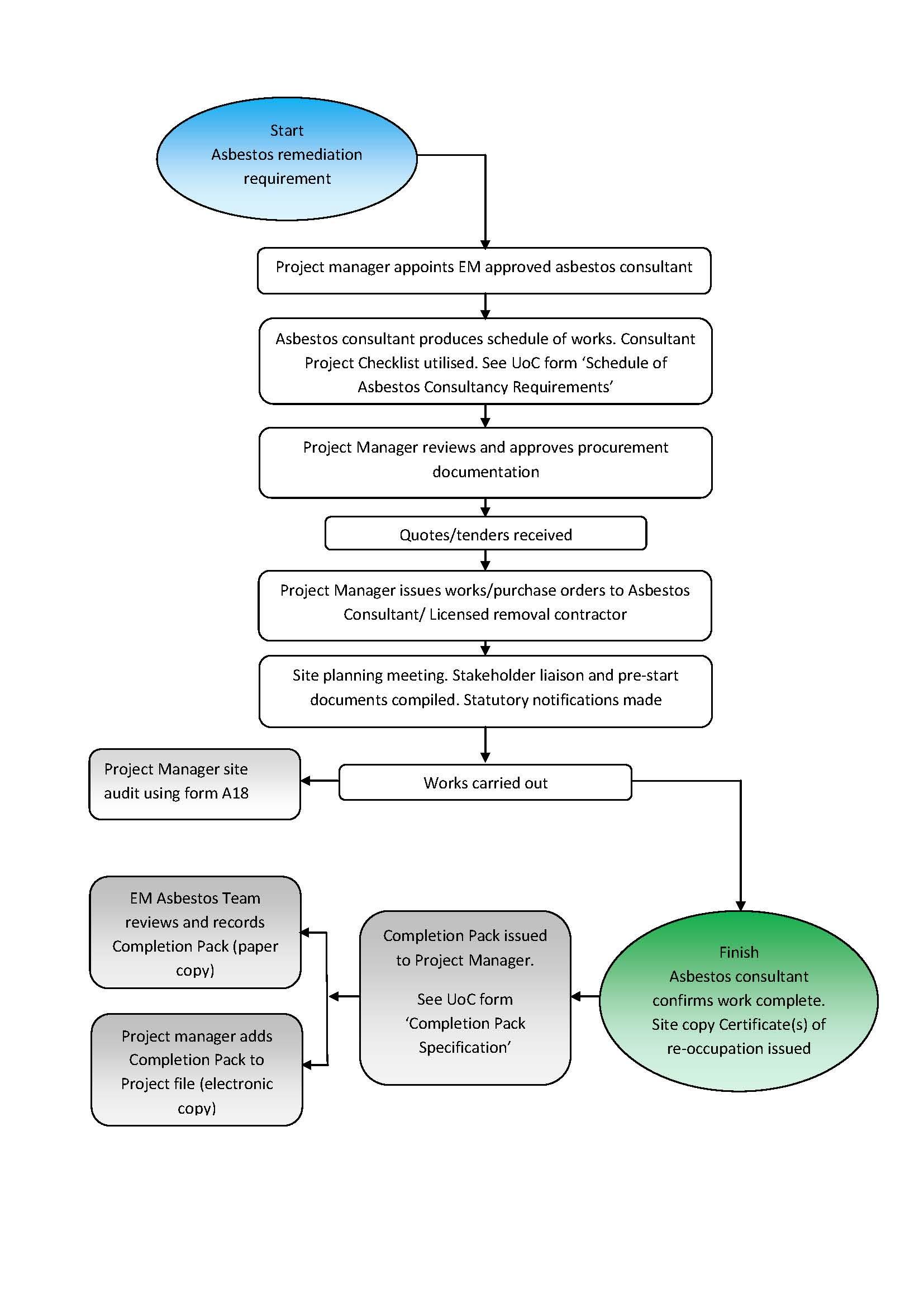This page contains information relating to two major activities in the buildings that are confirmed as containing asbestos, or where asbestos might be found:
-
Maintenance and small works, such as putting up shelving,
-
Refurbishment work.
Section 1: Maintenance and small works
Maintenance and small works in the buildings that are known to contain asbestos are subject to the following rules. A printable version of this section is available as document A3.
No person in the University is permitted to work on asbestos or to disturb it in any way whatsoever
Only asbestos specialists on the EM approved list are permitted to work with asbestos
Preparation
Checking the records and dissemination of information
Before embarking on any work in buildings that contain asbestos materials the asbestos register must be consulted to check whether the area has been subject to asbestos removal, and what is known about any asbestos-containing materials in the area. The information must be passed to the person who is doing the work. The form for requesting asbestos information is The University AIRF, which can be downloaded here.
Authorisation to do the work
The person doing the work must have received asbestos awareness training, either from the Department (as in A8), or from another reputable source.
Contractors engaged to do work in the buildings must be given an induction to warn them of the dangers present in the buildings, including asbestos. The handbook that is given to them is here.
The area where they work must be surveyed for all identifiable hazards and made safe. They must be specifically warned of the locations of asbestos materials and instructed not to disturb them. They should have completed asbestos awareness courses so that they are aware of the danger of suspicious looking materials. They should be briefed on the emergency procedure for asbestos.
The form used to check the area for hazards is document A17, available here.
Work above the ceilings
Where asbestos clearance has been carried out
A suitably trained person (asbestos awareness, used of RPE), wearing respiratory protective equipment that has been subject to a face-fit test needs to access the ceiling void to check that the asbestos-proof barriers that surround the work area are intact.
- If not, halt the work and seek further advice, as in the emergency document, A6,
- If the barriers are intact, proceed with the work planned.
Where asbestos clearance has not been carried out
Follow the procedure outlined in the emergency document A6.
Drilling into the walls
Procedures for drilling the walls vary according to the location. For the site buildings the procedure is as follows (this flowchart is available as a pdf):

The detailed procedure of how to proceed is in document A9: Wall Drilling Procedures for W011, W012, W013, W014. A copy of the form to be used to record the assessment is document A10, available here.
If unforeseen asbestos is discovered during works:
- Suspend work activity in the area concerned immediately;
- Inform the EM Asbestos Team without delay, as detailed in the emergency document A6.
Section 2: Refurbishment
A printable version of this section is available as document A14.
Preliminary work
Objective
To ensure that any departmental led maintenance or project works are undertaken in line with University requirements.
These procedures implement the University rules for removal of asbestos (A19).
The overall preliminary processes to a refurbishment project are summarised in the following flowchart, which is available as a pdf document.

Implementation
In general, when conducting refurbishment works the asbestos will be removed at the first stage of the project. This should proceed as follows:
- Consult the asbestos register, using an AIRF form,
- Since our buildings have only received management surveys to date, it will be necessary to instruct a Refurbishment and Demolition Survey in order to identify the asbestos-containing materials present in the area. It is important to make the scope of this wide enough to be able to complete the project - for instance clearing a room within the inner boundaries of the walls may not be sufficient if a section of wall is to be removed.
- A copy of the report must be passed to all parties requiring information
- Surveys must be carried out by University approved contractors.
Refurbishment and Demolition Survey
This seeks to identify asbestos materials that could be disturbed during work but are concealed from view. The process is described in HSE document HSG264. The survey area must be fully accessible to the surveyor so that the necessary investigation techniques can be employed. The survey should be planned so that the surveyor understands the scope of the intended works, for any exclusions from the survey to be agreed with the project manager and for arrangements to be made to clear and isolate the survey area.
The following are required:
- The survey area must be unoccupied
- the project manager must provide the surveyor, on request, any site/building plans, project drawings or specifications, and any history of asbestos work.
- the project manager shall also provide the surveyor with any known details of pre-existing structures or buildings previously demolished, underground ducts or shafts etc.
- the area is to be fully accessible, with fixtures, furnishings and heavy equipment removed, or at least easily movable
- the area is fully accessible in terms of isolation of services and other authorisations
- the surveyor's risk assessment will necessitate assistance for the identification of hazards, including means to work safely at height, key holder assistance etc. The survey normally involves invasive survey techniques which may be disruptive, destructive or even involve asbestos disturbance.
- the project manager or their delegate must participate in a pre-start site meeting with the asbestos surveyor to agree the exact scope of the refurbishment or installation works and therefore the scope of the survey that will be required.
Whenever the survey area is to be re-occupied assurance that it is safe to do so must be obtained from the asbestos consultant.
Once this has been done, dependent on the findings, the asbestos removal can be put out to contract to one of the University approved contractors. This is often an opportunity to remove asbestos from difficult areas such as the cladding on the steel structures.
This process is summarised in the following flowchart.

Asbestos Removal
The contract for asbestos removal needs to be drawn up carefully to ensure that all the asbestos in the area of the project is removed, and to avoid the project coming to a halt part-way through. Where practicable, all the asbestos containing materials in the area should be removed.
The removal contractors must be on the EM approved list. They should demonstrate knowledge of relevant current legislation pertaining to the safe removal of asbestos and awareness of other health & safety legislation and hazards that may be encountered on site. Information provided to tendering companies should include an asbestos survey report with fully annotated plans, full scope of works, information regarding any non-asbestos hazards relevant to the work area and any working practices required for working on the site.
They must be shown the findings of the Refurbishment and Demolition survey. They must also be given a site induction to inform them of any hazards in the area that have not been removed or isolated prior to their works. This may include the identity of the pipework in the area, and instructions as to how to handle emergencies.
Prior to the commencement of any removal works the licensed asbestos removal contractor appointed will be expected to:
- Provide a method statement and risk assessments on how the asbestos is going to be removed;
- Attend a pre-contract site meeting.
The appointed asbestos analyst / consultant will be expected to prepare, review and comment on asbestos removal works specifications and prior to commencement of the works the contractor’s method statement on behalf of the Department.
Within the University only UKAS accredited companies on the approved list will be commissioned to undertake survey works or analytical work. For survey works the company should be accredited to ISO 17020 and for analytical works to ISO 17025.
Unless commissioned through a principal contractor the Department will engage the services of an analytical company directly. Under no circumstances should the asbestos removal contractor engage the services of the analysts on behalf of the Department.
The approved analytical company will be employed by the Department to oversee the smoke testing, provide air monitoring (including leak testing where appropriate), conduct the four stage clearance procedure and oversee the contractor at all stages of the works. The analytical company will also be expected to attend any pre-start meetings, progress meetings and a handover meeting so that the Department is kept fully informed at all times.
The protocol for removal works is in this diagram:

The following documents should be used in this phase, where appropriate:
Project manager's checklist (A16)
Audit form for asbestos works (A18)
On completion of any asbestos remedial works the project manager should ensure that the person of authority is provided with a completion document. This document should be retained with the project file in a central stored location. The completion document should include the following:
- Air monitoring certificates;
- Waste consignment notes;
- Removal contractor’s method statement;
- Updated plans illustrating all asbestos items that have been removed and all asbestos that has been retained.
The person of authority is responsible for passing the information onto the the responsible person at EM who is in return responsible for updating the asbestos register.
The completion documentation should be placed in the Health & Safety file of the project.
Unforeseen asbestos
If unforeseen asbestos is discovered during works (including after the asbestos removal phase, if applicable):
- Suspend work activity in the area concerned immediately;
- Inform the EM Asbestos Team without delay.
- Please see document A6.
Supplementary information
Good practice guide for the asbestos register (A25)
About asbestos online; the University asbestos register (A26)
University rules for conducting asbestos removal works (A19)
Control of asbestos regulations 2012 (A22)
Acquisition and disposal of property (A12)
Location of asbestos survey information; these online at http://www.asbestos-online.co.uk/Default.aspx (requires a user name and password).
Location of training records; these are in the Department training records in the folder 'access databases' in the safety documents in 'Y'
Checksheet for review of Department system (A5)
